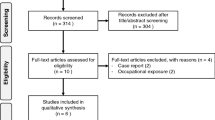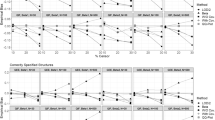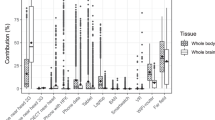Abstract
Many epidemiological studies assessing the relationship between exposure and disease are carried out without data on individual exposures. When this barrier is encountered in occupational studies, the subject exposures are often evaluated with a job-exposure matrix (JEM), which consists of mean exposure for occupational categories measured on a comparable group of workers. One of the objectives of the seven-country case-control study of occupational exposure and brain cancer risk, INTEROCC, was to investigate the relationship of occupational exposure to electromagnetic fields (EMF) in different frequency ranges and brain cancer risk. In this paper, we use the Canadian data from INTEROCC to estimate the odds of developing brain tumours due to occupational exposure to EMF. The first step was to find the best EMF exposure surrogate among the arithmetic mean, the geometric mean, and the mean of log-normal exposure distribution for each occupation in the JEM, in comparison to Berkson error adjustments via numerical approximation of the likelihood function. Contrary to previous studies of Berkson errors in JEMs, we found that the geometric mean was the best exposure surrogate. This analysis provided no evidence that cumulative lifetime exposure to extremely low frequency magnetic fields increases brain cancer risk, a finding consistent with other recent epidemiological studies.
This is a preview of subscription content, access via your institution
Access options
Subscribe to this journal
Receive 6 print issues and online access
$259.00 per year
only $43.17 per issue
Buy this article
- Purchase on Springer Link
- Instant access to full article PDF
Prices may be subject to local taxes which are calculated during checkout








Similar content being viewed by others
References
Turner MC, Benke G, Bowman JD, Figuerola J, Fleming S, Hours M et al. Occupational exposure to extremely low-frequency magnetic fields and brain tumor risks in the INTEROCC study. Cancer Epidemiol Biomarkers Prev 2014; 23: 1863–1872.
Bowman J, Touchstone J, Yost M. A population-based job exposure matrix for power-frequency magnetic fields. J Occup Environ Hyg 2007; 4: 715–728..
Berkson J . Are there two regressions. Journal of the American Statistical Association 1950; 45: 164–180.
Heid I, Kuchenhoff H, Miles J, Kreienbrock L, Wichmann H . Two dimensions of measurement error: Classical and Berkson error in residential radon exposure assessment. Journal of Exposure Analysis and Environmental Epidemiology 2004; 14: 365–377.
Kim HM, Burstyn I . Bayesian method for improving logistic regression estimates under group-based exposure assessment with additive measurement errors. Archives of Environmental & Occupational Health 2009; 64: 261–265.
Steenland K, Deddens JA, Zhao S . Biases in estimating the effect of cumulative exposure in log-linear models when estimated exposure levels are assigned. Scandinavian Journal of Work, Environment & Health 2000; 26: 37–43.
Carroll R, Ruppert D, Tefanski L, Crainiceanu C . Measurement error in nonlinear models. A modern perspective. Chapman & Hall/CRC. Monographs on Statistics and Applied Probability: Boca Raton, FL. 2006.
Stroud AH . Approximate Calculation of Multiple Integrals. Prentice-Hall: Englewood Cliffs: N.J.. 1971.
Spiegelman D, Rosner B, Logan R . estimation and inference for logistic regression with covariate misclassification and measurement error in main study/validation study designs. Journal of the American Statistical Association 2000; 95: 51–61.
Thomas D, Stram D, Dwyer J . Exposure measurement error: Influence on exposure-disease relationships and methods of correction. Annual Review of Public Health 1993; 14: 69–93.
Golub GH, Welsch JH . Calculation of Gauss quadrature rules. Mathematics of Computation 1969; 23: 221–230.
Higdon R, Schafer DW . Maximum likelihood computations for regression with measurement error. Computational Statistics & Data Analysis 2001; 35: 283–299.
Crouch EAC, Spiegelman D . The evaluation of integrals of the form S f(t) exp (-t2 dt: Application to logistic-normal models. Journal of the American Statistical Association 1990; 85: 464–469.
Gonzalez J, Tuerlinckx F, De Boeck P, Cools R . Numerical integration in logistic-normal models. Computational Statistics & Data Analysis 2006; 51: 1535–1548.
Breslow NE, Day NE . The Analysis of Case-Control Studies. IARC Scientific Publications, International Agency for Research on Cancer: Lyon, France. 1980, pp 32.
Cox DR, Hinkley DV . Theoretical Statistics. Chapman & Hall: London, UK. 1974.
SAS Institute Inc. The SAS system for Windows. Release 9.2, Cary, NC, USA 2011.
MathWorks Inc MatLab (r2011b). Natick: MA, USA. 2011.
Fuller WA . Measurement Error Models. Wiley: New York, USA. 1987.
Armstrong BG . Effect of measurement error on epidemiological studies of environmental and occupational exposures. Occup Environ Med 1998; 55: 651–656.
Koeman T, van den Brandt PA, Slottje P, Schouten LJ, Goldbohm RA, Kromhout H et al. Occupational extremely low-frequency magnetic field exposure and selected cancer outcomes in a prospective Dutch cohort. Cancer Causes Control 2014; 25: 203–214.
Acknowledgements
This research was conducted in part while the first author was visiting the Centre for Research in Environmental Epidemiology (CREAL) at the University of Barcelona in the fall of 2010. The authors are grateful to Jordi Figuerola at CREAL for his assistance in preparing the data files used in this paper. D. Krewski is the Natural Sciences and Engineering Research Chair in Risk Science at the University of Ottawa. J Siemiatycki holds the Guzzo-Cancer Research Society Chair in Environment and Cancer, at the Université de Montréal. The INTEROCC study was funded by the National Institutes for Health (NIH) Grant No. 1R01CA124759 (PI E. Cardis).
Author information
Authors and Affiliations
Consortia
Corresponding author
Ethics declarations
Competing interests
Dr Cardis is the principal investigator of the INTEROCC study, which is funded by the NIH. The authors declare no other conflicts of interest.
Additional information
DISCLAIMER
The findings and conclusions in this paper have not been formally disseminated by the National Institute for Occupational Safety and Health and should not be construed to represent any agency determination or policy.
Supplementary Information accompanies the paper on the Journal of Exposure Science and Environmental Epidemiology website
Supplementary information
Rights and permissions
About this article
Cite this article
Oraby, T., Sivaganesan, S., Bowman, J. et al. Berkson error adjustment and other exposure surrogates in occupational case-control studies, with application to the Canadian INTEROCC study. J Expo Sci Environ Epidemiol 28, 251–258 (2018). https://doi.org/10.1038/jes.2017.2
Received:
Accepted:
Published:
Issue Date:
DOI: https://doi.org/10.1038/jes.2017.2
Keywords
This article is cited by
-
Adjusting for Berkson error in exposure in ordinary and conditional logistic regression and in Poisson regression
BMC Medical Research Methodology (2023)
-
Insights in the biology of extremely low-frequency magnetic fields exposure on human health
Molecular Biology Reports (2020)



